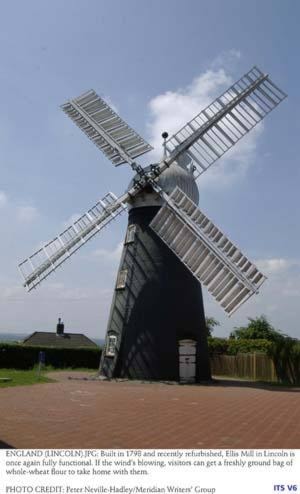LINCOLN, England—It is difficult to imagine a place whose main attractions are more conveniently laid out than those of slightly sleepy Lincoln. The town, founded by the Romans as a resort for retired legionaries nearly 2,000 years ago, later became a major ecclesiastical, military and commercial centre. Its magnificent, airy cathedral and squat, hulking castle face each other across a square of ancient housing which would itself be worth coming to see in its own right.
But Lincoln has much else to offer that’s neither so grand nor full of portent as cathedral and castle, and all within a few minutes’ walk. One of the best of these more domestic and approachable pleasures is a visit to the sturdy black cone of Ellis Mill. Unexpectedly tucked away amidst terraced housing behind the castle, the windmill once stood with eight others in open countryside along the edge of an escarpment in order to catch the best of the moving air.
Built in 1798 and recently refurbished with parts scavenged from other, partly dismantled windmills across the county, it’s once again fully functional. When there’s enough wind the creaking sails mounted on its onion-shaped white cap turn eagerly into it and rotate ponderously, but majestically.
“We don’t really want the sails to spin any faster than around about 12 revolutions a minute,” says Ellis Mill volunteer miller Barry Brook, “because everything is geared to that speed. Twelve revs a minute is 120 at the stone, and it’s an abrasive process, so the flours get warm. If you go too fast they get hot and spoilt.”
Climbing the conical interior hand-over-hand up ladder-like stairs, Brook points out the different loading chutes for the grain on the top floor, which feed it by gravity to a choice of two sets of 43-centimetre-thick millstones on the middle floor. He explains the skill needed to adjust the distance between the grinding stones and to calculate the right angle of the shutters within the whirring sails, controlling the wind’s effect on them and thus the overall speed of the process.
Grooves on the inner surfaces of the millstones act as scissor blades, cutting and grinding the grain to a powder, which filters out of the grooves on the lower, stationary millstone.
“Grain in, dust out. It’s an instant process,” says Brook with some satisfaction, standing amidst the rumble and creak of the ancient machinery, whose wooden and metal cogs exude mixed odours of metallic oil and earthy wheat.
The windmills were victims of the same 19th-century industrialization that eventually built Britain’s metropolises, funnelled trade elsewhere and turned Lincoln into a backwater. Giant, steam-driven mills with sequences of steel rollers produced a pure-white flour that the windmills, even by introducing a harder, more finely grooved millstone from France and a sieving process to remove the bran, could not match.
But bags of Ellis Mill’s tiny production of far more nutritious whole-wheat flour are now back on sale to visitors, weather permitting, and it’s hard to think of a more satisfying souvenir.
Access
For more information on Ellis Mill visit the Lincolnshire County Council webpage about it at www.lincolnshire.gov.uk/section.asp?docId=46233.
For information on travel in England go to the Visit Britain website at www.visitbritain.com.
